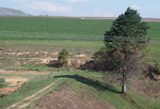Weaver species
Choose different species from drop-down list and press 'Go' button. See Full species list.Orange Weaver Ploceus aurantius
IUCN: Least concern Discovery: 024Categories: golden, wetland, fruit, waterbirds, palm,
News items about species
Discovery
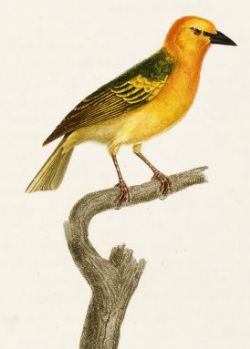
figure from Vieillot 1805 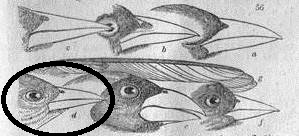
compared to other weavers, figure from Swainson 1838 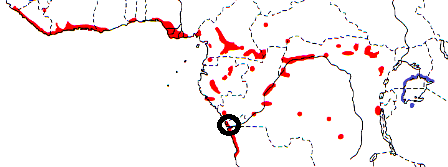
distribution, type locality circled IntroductionThe Orange Weaver was formally described by Louis Jean Pierre Vieillot, a French ornithologist. The birds had been collected by Jean Perrein, a French naturalist, who travelled in Africa and on other continents. Vieillot was interested in the habits of living birds, but Perrein did not seem to provide any field notes for the Orange Weaver, as he had done for the Crested Malimbe.Vieillot mentioned that the Orange Weaver had been collected in the same area as the previous species in his publication, ie. the Crested Malimbe. Thus the type locality is Malimbe, now called Malembo, in Cabinda, Angola. Perrein sent his specimens to Academy of Sciences in Bordeaux, France, from where the Orange Weaver type was moved to the Paris Museum (Swainson 1838). Scientific citationMalimbus aurantius Vieillot 1805 Ois. Chant. p.73 Malimbe.Meaning of namesaurantia Mod. Latin aurantius, orange-coloured, tawny (aurantia, an orange).First English nameOrange Weaver (Shelley 1905)Alternate namesUganda Orange Weaver.CollectorJean Perrein.Date collectedBefore 1805.Locality collectedMalimbe =Malembo, Cabinda, Angola.Type specimensType specimen probably still in the Natural History Museum in Paris. |
The above is based on Weaver Wednesday 2, a weekly series about the discovery of each weaver species.
This species text first appeared as
Weaver Wednesday [141] - Discovery [24]: Orange Weaver on 2015-02-25
1. Basic biology
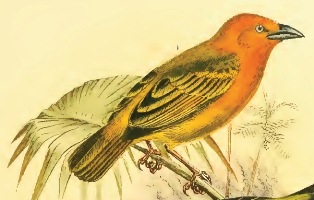
figure from Reichenbach 1863 Identification. The Orange Weaver Ploceus aurantius has a pale slender bill and reddish-brown or pale grey eye. The male is orange-yellow, sometimes with a black spot in front of the eye. The female and young birds are dull coloured. There is no seasonal change in plumage. According to Nik Borrow, the eye colour of western Orange Weavers (aurantius) is red and those of Ugandan Orange Weavers (rex) is pale bluish (photos on facebook). Distribution.
The Orange Weaver is localized, often uncommon, and occurs from Sierra Leone in West Africa across to Lake Victoria, and south to northern Angola (see map below, based on Birds of Africa). Two subspecies of the Orange Weaver are recognised:
A third subspecies, P. a. royrei is not valid but the type may be viewed here. In Liberia, Orange Weavers are found along the coast and on rocky islets up to 1.5 km offshore, where they nest low down in shrubs on the leeward side but commute to the mainland for foraging. Habitat. The Orange Weaver inhabits mangroves, thickets in coastal lagoons, small creeks and esturies in West Africa; inland it occurs along major rivers; and around Lake Victoria it is found in papyrus swamps. Food. It feeds on fruit, including berries, fruit pulp and seeds; also insects, including adults and eggs of locusts, beetles, and caterpillars. It is usually found in pairs or small groups. Breeding. The Orange Weaver is probably polygynous. It is colonial, and there may be between 12 and several hundred nests at some sites, but sometimes single nests. Nest sites include reeds, palms and other trees. It may form mixed colonies with other weavers. The nest is built by the male. The nest is ovoid, with no entrance tunnel in central and West Africa, and with a short tunnel in Uganda. The nest is tightly woven from grass or palm strips. The eggs (clutch of 2) are pale blue, green, brown or reddish, with fine lilac and brown spots, usually denser at the thick end. Incubation is by the female. |
The above is based on Weaver Wednesday, a weekly series about weaver species.
This species text first appeared as
Weaver Wednesday [51]: Orange Weaver on 2013-06-05
2. Breeding facts
| Pair bond Presumably polygynous Breeding season Oct-Apr in Liberia, Jun-Jul in Ghana and Togo, Feb, Jun, Sept and Nov-Dec in Nigeria, Oct-Mar in Gabon, Dec and Feb in PRCongo, possibly all months in DRCongo (Apr-Sept in Ituri, Jan in Itombwe), and Feb-May in Uganda Nest site placed 1.5-3 m above water in reeds or similar, up to 5 m over land in tree or bush; on offshore islets, low down in shrub on leeward side Nest building built by male Colony size Colonial, with several hudred nests at some sites, also isolated single nests Clutch size 2 eggs Egg colour pale blue, green, brown or sometimes reddish, with fine lilac and brown spotting, denser at thick end Egg size average size 21 x 14.5 mm (Uganda) Incubation incubation by female, in captivity period 13-14 days Chicks and nestling period nestling period in captivity 13-16 days |
Breeding information based on Handbook of the Birds of the World, Vol. 15.
3. Photos of Weaver Nests
 Vm 27826 |  Vm 26342 |  Vm 13829 | 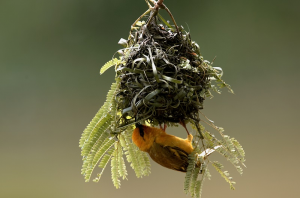 Vm 13803 | 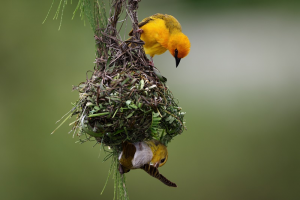 Vm 13802 | 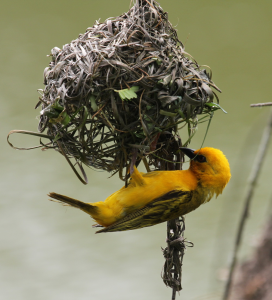 Vm 9888 |
Thumb-nails of most recent PHOWN records - click on one to see its full record
See all PHOWN records for this species here.
PHOWN (Photos of Weaver Nests) provides valuable info on breeding distribution and colony sizes of weavers.
You can contribute by registering and submitting photos at Virtual Museum webpage.
4. Breeding distribution
Google map showing distribution (For species with small ranges you need to zoom in at the correct area to see the range):
yellow blob - range of weaver species; read more about this here.
![]() - PHOWN records with photos
- PHOWN records with photos
![]() - PHOWN records with no photos (Nest Record Cards, other records)
- PHOWN records with no photos (Nest Record Cards, other records)
![]() - Birdpix records
- Birdpix records
![]() - comments on out of range records, or interesting records
- comments on out of range records, or interesting records
![]() - type locality
- type locality
CLICK on the marker on the map to see individual record details.
5. Range changes
Not South African speciesThe above is based on Weaver Wednesday 3, a weekly series about range changes in South African weaver species.
This species text first appeared as
n/a








